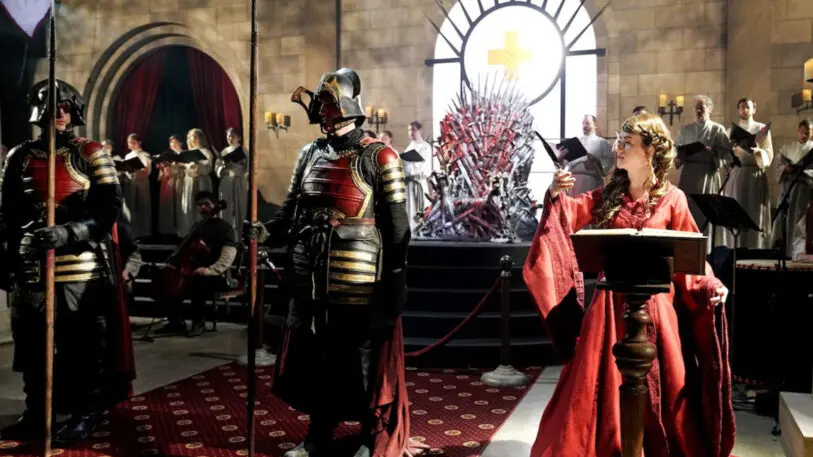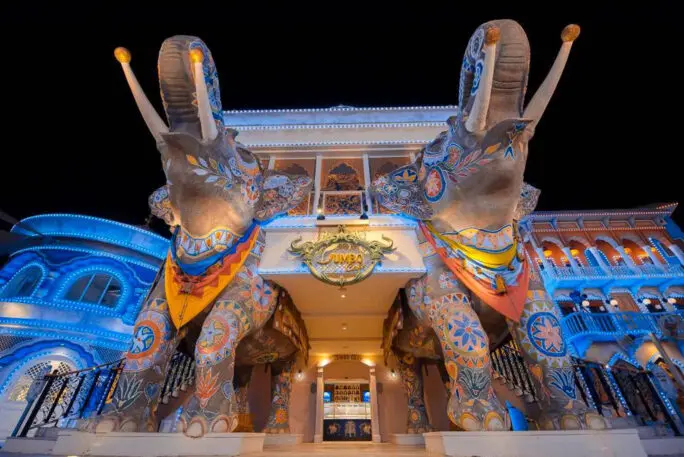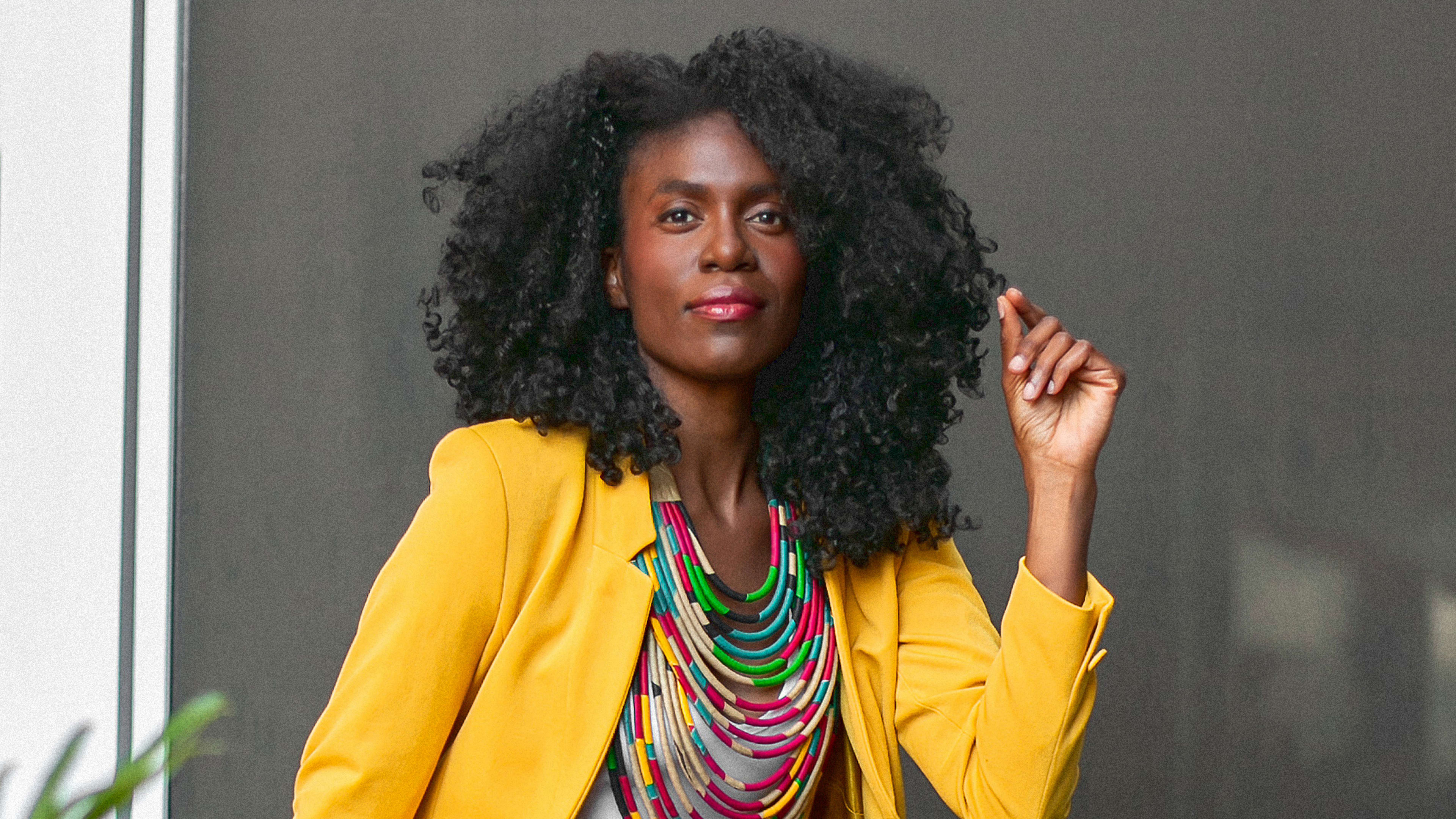Fri (pronounced “Free”) Forjindam is co-owner and chief development officer for Mycotoo, a global entertainment development and production agency that creates award-winning destinations, from theme parks and live events to museums and immersive brand experiences worldwide. She spoke to Doreen Lorenzo for Designing Women, a series of interviews with brilliant women in the design industry.
Doreen Lorenzo: How did you end up in the design field?
Fri Forjindam: How does anyone end up in this field? Divine stumble, I guess. I was born and raised in Cameroon, West Africa, so the notion of entertainment as a career just wasn’t part of the “when I grow up” bedtime story. My options were doctor, teacher, engineer, lawyer, and that was pretty much it. It wasn’t until I moved to the U.S. as a freshman in high school that I discovered the theater, and that love never ended.
Pretty early into college, I knew I wanted to pursue theater in New York but quickly recognized what the inconvenience of a premed, biology major pivot in undergrad would pose. The realization one night of seeing all my classmates studying for the MCAT while I was too busy memorizing lines for the spring musical (it was Cabaret, by the way) basically closed the deal.
By the time I graduated I decided I was going to go to New York. Armed with a BA in biology and a whole lotta dreams, I applied to Columbia University in secret and got in on a scholarship. That was the only way I was able to attend their MFA program. As an actor I took the expected path of auditions, rejection, bookings, casting calls, and waiting tables in between. But after experiencing my last blizzard and people not picking up after their dogs I said, “I’ve had it. I’m moving as far away from New York as I can … where there’s still entertainment, of course.” That was Los Angeles.
When I first moved to L.A. I got a job as an executive assistant to the owners of a theme park design company, working for the chief creative officer and a chief operating officer. I recognized pretty early on that everyone who was at my level wasn’t in the room that I would sit in on. Yes, I was there to keep the meeting minutes and organize calendars, but I realized that I was getting a pretty expensive amount of schooling by just showing up. My mindset shifted when I recognized this, and instead of just taking meeting notes, I figured I should really listen to how executives in the room (way more experienced than me) were problem-solving, strategizing, and designing in this industry. I worked my way up from that vantage point, asking “dumb” questions and getting curious about everything, taking some people to lunch to pick their brains, and not being afraid to speak up. It helped that I had a great mentor (who would go on to become one of my business partners at Mycotoo) who believed in my curiosity and saw more [in me] than I probably did in myself at the time.

FF: I use the term “theme park” because it’s the easiest thing for most people to grasp when describing what I do, but it’s really much more than that. I am a storyteller! I’ve always been. And the themed entertainment industry is this weird gumbo of storytellers, gamers, builders, makers, and problems-solvers who didn’t get enough of it from theater in high school. We never grew up, and essentially built a tribe of like-minded “Peter Pans.”
Theme park design is a multidisciplinary process that starts from blank page to opening day, where master-planned concepts are envisioned, rides and attractions are conceived, and an overarching story that speaks to the vision comes alive. There are typically multiple phases starting with concept design, into schematic development, production, fabrication, and construction. And yes, I’m simplifying it a bit for the sake of this conversation, but it still amazes me how much theme park design is like moviemaking, except typically at the end of the shoot, the sets and actors and crew have to stay on for years, even decades, keeping the experience as fresh as it was on the first day of production. Themed entertainment is about creating immersive worlds. It’s not just about building beautiful scenes, it is about starting with the why in delivering a story-driven experience that allows you to engage and interact with your unconscious, escape from normality, or challenge a new perspective through which to experience reality. That’s what we do and love at Mycotoo.
For us the principles of creative storytelling, production management, and operations in a traditional theme park unlocked an enthusiasm and flexibility in delivering a new kind of immersive experience. Spaces like retail, education, and museum exhibits are now expanding to include fresh, experiential overlays, digital interactivity, characters, and brand ambassadors to bring the vision to the forefront as a destination—to put you in the world that the brand is inviting you into. That’s themed entertainment.
It started from the theme park world but it has that philosophy of authentic storytelling that’s aspirational, entertaining, and fun, while also potentially being educational and socially driven. Those foundational principles are way beyond the theme park model. Theme parks are typically gated, while themed entertainment is porous and immersive.

DL: Tell us a bit more about Mycotoo. What are some of your favorite projects you’ve worked on?
FF: Working on the award-winning HBO’s SXSWestworld for sure! The road to Sweetwater started thousands of miles away in sunny California. Mycotoo has been operating successfully since 2011. And like so many great entrepreneurial stories, we started in a garage with only three people. The two founders—Clifford Warner and David Wally—and I worked in a home garage for two years, when I was pregnant with my second child. The optics of it couldn’t have been more perfect for an Awkward Black Girl satirical sketch. But what was really exciting about those times was that we had nothing to lose. We envisioned a new type of company to help passionate organizations and individuals achieve. In less than two years, what started as a long-shot effort to help with preliminary budgeting for an idea turned into a phone call that would change everything. We landed the contract to design a theme park in Dubai.
Six months after that call, we grew from three people in a garage to four partners (including our CEO, Seth Cover) and leading more than 160 designers, artists, show set architects, writers, and engineers. We were now designing two full theme parks: Motiongate Dubai, a Hollywood-inspired theme park featuring DreamWorks, Smurf, and Sony properties; and Bollywood Parks, which was inspired by Mumbai’s famous film industry. Bollywood is dear to my heart because it’s where I cut my teeth as a creative director on a theme park project. Both parks opened in 2016, and what a high it was to see a world that had been in my mind right there in front of me.

In 2017 Mycotoo was engaged by Giant Spoon to work on the scripting and casting for a San Diego Comic-Con activation for Warner Bros.’ Blade Runner 2049. We took over a parking lot and created Los Angeles in the year 2049. That was the beginning of this meteoric new vertical for us: brand experiences. We found ourselves on a brave new dance floor where our team’s collective experiences in themed entertainment, production management, theater, and experience design now twerked!
The following year Mycotoo was engaged by Giant Spoon again to travel to Austin for SXSW to work on what I can say without a doubt is one of our favorite projects: SXSWestworld. Re-creating Sweetwater’s Western aura for guests and competing for attention against the backdrop of the conference’s allure of flashy gadgets and cool tech was no easy process. Everyone was talking about it and using their devices to share their experience, so after only three days, an event that had targeted only a few thousand people in invited attendance garnered more than 1.9 billion online impressions. Those were some really great surprises for us. When something is so well received, it’s always great validation that we’re doing something right.
DL: How will the pandemic affect themed entertainment in the future?
FF: At the end of the day, we’re responsible for creating environments that feel safe enough for people to let their guard down, let go, and have an authentic and emotional connection. That was true before the pandemic and it is even more urgent now. Themed entertainment as an essential fuel will keep going beyond the pandemic because humanity has a long history of demanding and needing that emotional connection. Our industry is experiencing a record drop in employment and income. With the shutdown of large gatherings, the impact was felt immediately and I worry that it will be slow to resume to 100% attendance even after the bans are lifted. But return we will, because the show must and will go on; that’s who we are at our core.
In the meantime, the notion of a “destination” has shifted drastically. It’s your home. It’s your safe space with the people you live with. If the living room is the new destination and you’re bingeing on a streaming service, there’s often an inevitable isolation and fatigue—a “fourth wall” between you and the content/performer. The space allotted to inviting people into immersive worlds is going to expand. Zoom parties, drive-through attractions, virtual tastings, and escape rooms certainly offer a much-needed respite from stifling isolation, and it’s only getting more creative.
Organizations are introducing creative solutions where they’re blurring the lines between illusion and virtual storytelling with The Present at the Geffen Playhouse or the Travis Scott x Fortnite live virtual concert. If that immersive sensibility is now coming to me in the comforts of my living space, that means I, as a consumer, am actually inviting or accepting that experience into my home. It’s a different kind of social contract with very different approval parameters outside of driving distance and cost, but more related to time commitment and level of enrichment. If this is the new paradigm, it’s a much more intimate form of delivering and sharing experiences and will become more of a lifestyle addition. The pandemic has forced us to demote inauthentic narratives more quickly and be more proactive and innovative about how we invite our stories, brands, and experiences into other people’s spaces. Even after the pandemic, I believe the bar will be irreversibly elevated.
DL: How are you shifting your design strategy at Mycotoo in response?
FF: One thing never changes for us. We always start with the vision, the why. Even before the pandemic, we always made a point of starting with that as part of our design and development process—to get at the heart of any experience and tap into an authentic connection. It’s the kind of experience that inspires repeat visitation and brand loyalty. What’s the story you’re trying to tell? From there we decide how we translate it into heightened experiences for museums, resorts, live events, brand activations, or education. Then we decide what people, actors, and interactions we bring in. If you’re able to answer the why consistently through the design, then you’re onto an experience that has heart and will resonate with your audiences. While we’ve had to adjust our work environments to be more remote, our ability to design, produce, and oversee full productions has remained strong. The fall opening of Masha and the Bear Land of Laughter and Watermania, two new themed lands in Turkey’s Land of Legends entertainment resort and theme park, is a testament to that resilience.

But we also have to be conscious of human psychology and what guests are thinking. What are they scared of? Right now, it’s their health. Is it safe to have fun? Am I allowed to let go? Those questions determine how you lay out the space. It’s how you make people feel like they don’t even have to think about it. Everything’s already processed for them. The more we incorporate those answers into the early stages, the better. The great encouragement is that we are aligned with the Paisley Park team in their commitment to health and safety, and to the many programming enhancements toward delivering on the promise of bringing authentic storytelling, exhibit design, and music-driven experiences to Paisley. It’s truly an exciting and hopeful time. Our strategy is always rooted in putting yourself in the guest’s shoes and making the experiences as seamless as possible. That strategy hasn’t changed; it just has a few more safety benchmarks to include.
We’re also in such a politically conscious climate right now, that the notion of diversity and inclusion is just plain irresponsible to ignore. The themed entertainment industry cannot create sustainable attractions if they do not reflect the stories of today’s audience, nor the reach needed to be successful and relevant. The only way to do that authentically is to make sure that diversity outreach and empowerment is also reflected in the leadership, executive-level staffing, and creative process behind the scenes. The last few years (and especially 2020) have served as a reckoning for all of us on the role we play in perpetuating bias, microaggression, and racism at the personal, consumer, and corporate levels. I don’t claim to be the expert on where to harvest that magic anti-racist pill, but I find myself more and more unapologetic about using my platform and role in our industry in moving the needle, through involvement with like-minded nonprofit organizations and commercial partners who are steadfast on ensuring that true equality is part of the company culture. I don’t know how else to live, and I’m fortunate that I have a team around me that is equally motivated.
DL: Where do you get your inspiration from?
FF: I come from a lineage of strong women. My mother was one of the only women in Cameroon to own her own commercially successful venture—a chain of grocery stores that sold and distributed American and European products in the ’80s and ’90s. I mean she traveled to China back in the early ’90s to negotiate directly with her manufacturers. This just wasn’t done in 1993. Now it’s so common, but for a Black woman to have the audacity? I remember secretly admiring that. She really is my inspiration, but more recently, so are my children and husband. My daughter is a tour de force, a consumer of books and lover of mythical dragons. She is braver than I ever could have been at her age and she’s only 10 years old. She and her younger brother are both genuinely kind, yet fearless in a way that even I wasn’t, and I think I’m pretty tough. They give me hope for the future. They remind me about a future that hasn’t been written yet, and I want so desperately to witness that, and to do what I can to make the shoulder they stand on unflappable.
I’m also inspired by seeing brave new voices daring to shift the paradigm of narratives that we consume: Lena Waithe, Bozoma Saint John, Misha Green, Tomi Adeyemi! Their ways of approaching stories inspired me to see world-building and the possibilities within those scapes not as something to reduce to fantasy, but to elevate as possible. I want to continue to collaborate with creatives who dream like there is no box. Maybe that’s the Prince effect kicking in. Even if it is uncomfortable and provocative, it’s ways of using entertainment as a reflection of who we are. That’s what themed entertainment can be, a reflection of us. It is a mirror on our politics, our ideology, our sexuality, our loves and dislikes. I get inspired when I see people daring to be outliers. Those are things that make me realize I’m in the right industry, one that allows for a circus of ideas to fail gloriously.
DL: What do you tell young designers? What advice do you want to give them?
FF: That thing that keeps you up at night, that you’re really excited about, follow through with it and see where it goes. Don’t treat that nudging as a side hustle. Treat it as a calling, as a little knock on destiny’s door.
The biggest advice that my mom ever gave me as a kid was, “Have your own bank account.” I didn’t know what she really meant at the time. But as I got older, I realized that the bank account is not just a physical account. It’s autonomy. It’s a voice. It’s ownership. It’s wealth. That has been so profoundly impactful on me and how I approached owning my own business. The reason why I shifted my mindset is because I don’t want to be the talent on display. I want to own the studio.
Recognize your brand’s excellence by applying to this year’s Brands That Matter Awards before the early-rate deadline, May 3.
